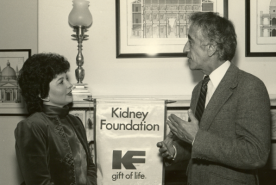September 26, 2024
Coping with kidney disease and dialysis can be difficult. Sometimes, you have to think outside the box. Have you considered music or art therapy? Melissa Frye, a social worker, and patient Steve Light, an artist from the United Kingdom known as SLART, are here to share their experiences with music and art as coping strategies.
Music Therapy and Dialysis
Kidney failure and dialysis can be tough experiences. Treatments are long, and many experience symptoms of discomfort like anxiety or itching. Music may help. Research1,2 suggests that listening to music during dialysis may help:
- Reduce pain during needle placement
- Reduce cramping
- Lower anxiety
- Decrease depression
- Manage blood pressure during treatment
- Offer relief from itching
"Many studies, mostly from other countries, have found that music can improve the quality of life for dialysis patients," Frye said. "In my unit, we've observed how beneficial music can be."
One notable case involved a patient who was extremely anxious about needle placement. To help, a technician started singing while inserting the needles. By the end of the song, the patient was surprised to find the needles were already in.
"Music can also help with those last 30 minutes of treatment, which tend to be the hardest.
Sometimes they listen to it themselves wearing headphones," said Frye. "Other times, we play music for the whole unit. Everyone's mood improves."
The benefits of music therapy are not limited to a single genre. Whether you like rock, gospel, rap, country, jazz, or any other genre, you can find music that fits your tastes and helps you feel better. Listen to NKF’s Dialysis Playlist created from suggestions by dialysis patients.
"Anyone can start using music therapy. Bring a pair of headphones. Sing or drum along as you listen," Frye said. "Talk to your dialysis clinic staff if you want to try using music during needle placement or as a unit-wide activity."
Art and Dialysis
While more studies on art and dialysis need to be done, preliminary results3 and experiences show that creating art may help:
- Increase happiness
- Reduce stress
- Decrease boredom
- Improve perception of time
- Increase relaxation
For Steve Light, making art helped him cope after his kidney transplant failed.
"I was diagnosed with high cholesterol and stage 3b kidney disease when I was 23 during a routine health check-up. I was confused because I didn't have any symptoms," Steve said. "After I got over the shock, I lived life as normal. Eight years later my kidney function declined and I started dialysis."
Steve spent the next year on dialysis before receiving his first transplant in December 2010.
"That transplant did well until April 2021. I caught COVID-19. After I recovered from that I started having shortness of breath during short walks," said Steve. "A few months later I was diagnosed with anemia and told my transplant would fail within the next two years."
This time, Steve experienced many symptoms associated with kidney failure, like exhaustion, loss of appetite, and trouble concentrating.
"I thought I had time, but my kidney failed in December 2021. Dialysis wasn't as scary the second time around and I started feeling better within a few weeks," Steve said. "I decided to paint about my experience with kidney failure in early 2022. My first piece is called Bloodlines, referring to the tubing of the dialysis machine."
Creating art gave Steve an outlet for his emotions. It helped him build himself up during a time when it would be easy to get discouraged.
"My psychologist encouraged me to continue my art since it is a great form of therapy and I already had experience with it," said Steve. "My first piece was quite serious but my art became more light-hearted overtime. I painted a whole series around my experiences and created a persona called Kidney Man, where I am a superhero facing dialysis."
In July 2022, Steve's brother donated a kidney–giving Steve another chance at a life off of dialysis. Since then, he's used his art to educate others about kidney disease and transplantation, inspire patients, and raise money to support organizations fighting kidney disease. One of his paintings was even shown in the UK Parliament during Organ Donation Week.
"Hearing that others on dialysis have started drawing after hearing my story has touched me the most," Steve said. "Art is for everyone. People say they can't draw, but they can. Even drawing shapes and coloring them while on dialysis can help. Lose yourself in it and have fun."
Need Support During Dialysis?
Join NKF Peers to get matched with a trained peer mentor with experience living well with kidney disease. Learn more about NKF Peers.
Sources
1Kishida M, Yamada Y, Inayama E, Kitamura M, Nishino T, Ota K, Shintani A, Ikenoue T. Effectiveness of music therapy for alleviating pain during haemodialysis access cannulation for patients undergoing haemodialysis: a multi-facility, single-blind, randomised controlled trial. Trials. 2019 Nov 19;20(1):631. doi: 10.1186/s13063-019-3773-x. PMID: 31744526; PMCID: PMC6862830.
2Cheng J, Zhang H, Bao H, Hong H. Music-based interventions for pain relief in patients undergoing hemodialysis: A PRISMA-compliant systematic review and meta-analysis. Medicine (Baltimore). 2021 Jan 15;100(2):e24102. doi: 10.1097/MD.0000000000024102. PMID: 33466179; PMCID: PMC7808445.
3Carswell, C., Reid, J., Walsh, I. et al. A mixed-methods feasibility study of an arts-based intervention for patients receiving maintenance haemodialysis. BMC Nephrol 21, 497 (2020). https://doi.org/10.1186/s12882-020-02162-4









